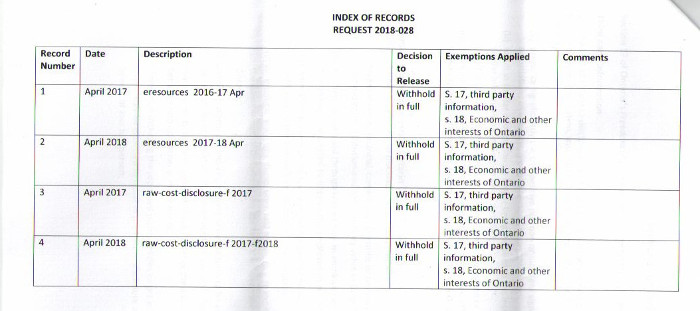I’m a librarian at York University Libraries in Toronto. Let’s call me Librarian Bill when I’m there. At home I’m Civilian Bill, and last month Civilian Bill put in a freedom of information request to York University for the amounts the Libraries spent on electronic resources in fiscal years 2017 and 2018. Civilian Bill knew the information exists because Librarian Bill prepared a spreadsheet with precisely those costs.
York has refused to release the data. Their response is “withhold in full.”
Background: other eresource cost data releases
Librarians generally believe that the costs their libraries pay for resources should be made public. Aside from people having the right to know where their money is going (in F2018 50% of York’s revenue came from students and 35% from the province), this is part of the move to making all publicly-funded research freely available online: one tactic is to show the exorbitant and increasing costs of closed subscriptions to journals and the like when it would actually be cheaper to make everything free and open. It’s always been normal for the total amount spent on collections to be public, but now more detailed information should be available: how much it costs to subscribe to JSTOR, PsycINFO, Nature, SciFinder and all the other hundreds of things that libraries pay for annually.
In Canada a few libraries have been doing this for years:
- University of Alberta subscription expenditures, F2014–F2017.
- Simon Fraser University Library serials costs, F1991–F2017 (has more than just serials).
Recently the big consortium of academic libraries, the Canadian Research Knowledge Network (CRKN), published Expenditures of CARL member libraries for scholarly resource subscriptions licensed through CRKN for 2016–2017. (CARL is the Canadian Association of Research Libraries.) It includes these costs paid by York:
| Product | Cost (CAD) |
|---|---|
| Cambridge Journals Online | 93,173.17 |
| MathSciNet and Consortium Database Fees | 12,865.73 |
| NRC Research Press Journals | 14,862.00 |
| Oxford Journals Online | 126,483.41 |
| RSC Electronic Journals | 31,164.85 |
| Sage Premier All-Access | 228,521.38 |
| ScienceDirect Freedom Collection | 1,406,367.81 |
| Scopus | 156,766.50 |
| Taylor & Francis Journals (SSH/S&T/Medical) | 691,874.95 |
| Web of Knowledge | 19,671.56 |
| Web of Science | 134,903.21 |
| Wiley Online Library | 590,217.56 |
Releasing cost data is complicated by the way vendors sometimes put non-disclosure agreements in their contracts. Many don’t—often pricing is up on the vendor’s web site, especially, for example, for institutional subscriptions to things like The Journal of Something Defined Very Particularly where it’s $250 instead of $60 for an individual. Where vendors do prevent disclosure of costs, it’s so they can play libraries off against each other and not reveal that they gave a special deal to another place. This is one part of what helps major scholarly publishers have profit margins of 35% or more.

York University Libraries plans to release cost data
Early in 2017 Librarian Bill was part of a group at York University Libraries that resolved to make public the costs YUL spent on electronic resources. There was institutional support for this. The eresources librarian went through scores and scores of license agreements to figure out which had NDAs and which didn’t—this was pretty tedious work—and Librarian Bill matched those up with products and costs and made a spreadsheet that looked like this:
| t | vendor | consor | publisher | title | nda | F2017 |
|---|---|---|---|---|---|---|
| i | Elsevier | CRKN | ScienceDirect | NO | 1406368 |
It had about 800 rows. The “t” column is the type, an internal code so we can distinguish between journals, data sources, etc. Publisher here is blank but sometimes we buy access to a title not from the (small) publisher but from a (larger) vendor and in such cases that’s recorded. The NO in the “nda” column means that there isn’t an NDA preventing us from releasing the costs.
(Note: the cost given there is the CRKN cost rounded; this is already public.)
This data was not released. In April of this year the fiscal year ended and in May Librarian Bill added the F2018 costs to the spreadsheet after the eresources librarian checked new licenses for NDAs. There was no progress on releasing this updated data. In fact there was no sign the data would ever be released.
Bullshit
Right around then Jane Schmidt (a librarian at Ryerson University in downtown Toronto) posted the text of Innovate this! Bullshit in Academic Libraries and What We Can Do About It, the talk she gave in May at the conference of the Canadian Association of Professional Academic Librarians. In section 6, “We are terrible at business but spend a lot of money,” she says:
In 2016/2017, the University of Alberta spent $7,289,007.31 on services and products from ProCLC and Ebquest. Sure, UofA is a heavy hitter when it comes to collections expenditure, but I am willing to bet that every single university library in Canada does business with these companies and pays a minimum of triple figures and upwards of millions in most cases. We tend to focus a lot of our outrage on the money spent with the big five publishers—which, don’t get me wrong—are a major problem, but in terms of the amount of contact our staff, students and researchers have with the tools, content and services provided by these aggregators, we really need to pay very close attention to how these products are actually working. We’ve been told by more than one of our vendor reps during these circuitous exchanges that they are surprised they don’t get more detailed questions from libraries.
My challenge to all of you here today is to go back to your libraries and start shining a light into the deep recesses of the databases you use…. Do you know how much your library spends on the products you use every day? Are you able to speak confidently on how those prices have fluctuated over time and why they have? If something doesn’t work the way that we think it should or as it is advertised, why is an increase in price—no matter how modest—a given? These are all questions that we need to start asking more consistently. Also, thank you, Simon Fraser University and University of Alberta, for taking the lead on sharing your expenditure data.
“She’s right,” Civilian Bill and Librarian Bill said to myselves. “Let’s make use of our rights under provincial legislation and try to get the data released through a FIPPA request.”
My FIPPA request
On 10 July 2018 Civilian Bill used the form on York’s Making an Access to Information Request page:
I request the costs paid by York University Libraries for subscribed eresources in fiscal years 2017 and 2018. “Eresources” means electronic resources, which includes but is not limited to online journals, proprietary data sets, article indexes and databases, and multimedia streaming services (but not ebooks).
I request not an aggregate sum but the individual costs paid for each product: JSTOR, PsycINFO, Books 24x7, Metal Music Studies, etc. Some costs will be protected under a nondisclosure agreement. For those I request that the product be listed but I understand it may not be possible to also include the price.
As examples of what this data looks like, here are two Canadian university libraries that have released theirs:
- Alberta: https://doi.org/10.7939/DVN/10844
- Simon Fraser: https://www.lib.sfu.ca/about/overview/collections/serials-costs
The Canadian Association of Research Libraries released costs paid by CRKN members, which includes York: http://dx.doi.org/10.20383/101.033 . This is where York gets access to large packages such as Elsevier’s ScienceDirect. This is just a small fraction of the total number of eresources York has, however.
Preferred method of access is a spreadsheet (a printout will suffice).
Civilian Bill had the advantage here of knowing this information was available and would take under an hour to pull because Librarian Bill had prepared the data and left instructions on how to generate a list of all eresource costs where there was no NDA.
Civilian Bill was really hoping that Librarian Bill would be the one asked to look for the requested information, but he wasn’t.

York’s response
On 24 July York sent a letter saying they had received Civilian Bill’s request on 17 July and that they had 30 days to respond. On 13 August they sent a letter (postmarked 17 August) which Civilian Bill received on 21 August. It said:
A search for responsive records was conducted and four documents located.
Access to these records is being denied under sections 17 and 18 of the Act.
This is the index of the four responsive records:

It is correct: those four documents all contain the data. The last one, raw-cost-disclosure-f2017-f018, is the updated one Librarian Bill prepared with all the data prepped and ready to go. But for each of the four, the “decision to release” is “withhold in full.” Withhold in full!
Two exemptions are cited from the Freedom of Information and Protection of Privacy Act, R.S.O. 1990, c. F.31 as reasons not to supply the information. First, S. 17, Third party information, which says in part:
17 (1) A head shall refuse to disclose a record that reveals a trade secret or scientific, technical, commercial, financial or labour relations information, supplied in confidence implicitly or explicitly, where the disclosure could reasonably be expected to,
(a) prejudice significantly the competitive position or interfere significantly with the contractual or other negotiations of a person, group of persons, or organization;
(b) result in similar information no longer being supplied to the institution where it is in the public interest that similar information continue to be so supplied;
(c) result in undue loss or gain to any person, group, committee or financial institution or agency.
Second, S 18, Economic and other interests of Ontario, which says in part:
18 (1) A head may refuse to disclose a record that contains,
(a) trade secrets or financial, commercial, scientific or technical information that belongs to the Government of Ontario or an institution and has monetary value or potential monetary value;
(c) information where the disclosure could reasonably be expected to prejudice the economic interests of an institution or the competitive position of an institution;
(d) information where the disclosure could reasonably be expected to be injurious to the financial interests of the Government of Ontario or the ability of the Government of Ontario to manage the economy of Ontario;
(e) positions, plans, procedures, criteria or instructions to be applied to any negotiations carried on or to be carried on by or on behalf of an institution or the Government of Ontario.
Civilian Bill and Librarian Bill leave it to the reader to think about whether those claimed exemptions are valid. Neither of us thinks they are.
YUL’s support for democratizing scholarship
Neither Civilian Bill nor Librarian Bill were expecting this. We figured we’d be told the responsive records could be released in part, with redactions where NDAs prevented the costs becoming public. There would be a small access fee, which Civilian Bill would pay, and then he would publish the data. Because it was now public, York University Libraries would release it properly, with Librarian Bill helping. The roadblock to open release, whatever it was, would have been overcome. But that didn’t happen.
Part I of York University Library’s 2016–2020 strategic plan, the section titled “Transformative Knowledge Infrastructure and Scholarly Content,” says the Libraries will:
Support the academic priorities of the University at the Glendon, Keele and Markham campuses through an intentional commitment to sustaining open access, democratizing scholarship, and developing a robust and responsive knowledge infrastructure that anticipates the evolving scholarly record.
One of YUL’s values is “We believe in advancing the democratization of knowledge.”
The actions do not match the words.
 Miskatonic University Press
Miskatonic University Press